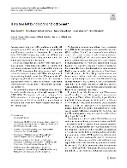Is it a true left bundle branch block or not?

Autor
Jurák, Pavel
Chelu, Mihail G.
Datum vydání
2023Publikováno v
Journal of Interventional Cardiac ElectrophysiologyRočník / Číslo vydání
66 (6)ISBN / ISSN
ISSN: 1383-875XMetadata
Zobrazit celý záznamTato publikace má vydavatelskou verzi s DOI 10.1007/s10840-023-01530-y
Abstrakt
Among patients with wide QRS complexes of nonRBBB morphologies on ECG, there are those with preserved left septal Purkinje activation, i.e., intraventricular conduction delay (IVCD). Unfortunately, twelve lead ECGs do not allow to discriminate them reliably from those with disrupted LBB activation, i.e., trueLBBB. IVCD and trueLBBB differ in the ventricular activation sequence. While during trueLBBB, LV lateral wall activation is postponed due to the trans-septal conduction delay, IVCDs have various LV activation patterns. Left ventricular activation during trueLBBB can be reproduced by pre-existing the right ventricular (RV) septum with RV septal pacing (RVSP). On the other hand, RV septal pacing in patients with IVCD leads to additional trans-septal conduction delay, which is not present during the spontaneous rhythm. The activation sequence of ventricular segments may be easily visualized using an ultra-high-frequency ECG (UHF-ECG). We hypothesized that by studying UHF-ECG ventricular activation sequences during the spontaneous rhythm and RVSP, we could discriminate between trueLBBB and IVCD and observe different responses to RV septal pacing.
Klíčová slova
ECG, intraventricular conduction delay, UHF-ECG, ventricular activation, ventricular depolarization patterns
Trvalý odkaz
https://hdl.handle.net/20.500.14178/2148Licence
Licence pro užití plného textu výsledku: Creative Commons Uveďte původ 4.0 International







